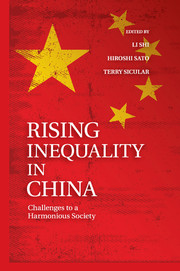Book contents
- Frontmatter
- Contents
- List of Tables
- List of Figures
- Contributors
- Preface
- Abbreviations
- Glossary
- 1 Rising Inequality in China
- 2 Overview
- 3 Housing Ownership, Incomes, and Inequality in China, 2002–2007
- 4 Educational Inequality in China
- 5 Inequality and Poverty in Rural China
- 6 The Evolution of the Migrant Labor Market in China, 2002–2007
- 7 A New Episode of Increased Urban Income Inequality in China
- 8 Unemployment and the Rising Number of Nonworkers in Urban China
- 9 Do Employees in the Public Sector Still Enjoy Earnings Advantages?
- 10 Redistributive Impacts of the Personal Income Tax in Urban China
- 11 Changes in the Gender-Wage Gap in Urban China, 1995–2007
- 12 Intertemporal Changes in Ethnic Urban Earnings Disparities in China
- Appendix I The 2007 Household Surveys
- Appendix II The 2002 and 2007 CHIP Surveys
- Index
- References
11 - Changes in the Gender-Wage Gap in Urban China, 1995–2007
Published online by Cambridge University Press: 05 July 2013
- Frontmatter
- Contents
- List of Tables
- List of Figures
- Contributors
- Preface
- Abbreviations
- Glossary
- 1 Rising Inequality in China
- 2 Overview
- 3 Housing Ownership, Incomes, and Inequality in China, 2002–2007
- 4 Educational Inequality in China
- 5 Inequality and Poverty in Rural China
- 6 The Evolution of the Migrant Labor Market in China, 2002–2007
- 7 A New Episode of Increased Urban Income Inequality in China
- 8 Unemployment and the Rising Number of Nonworkers in Urban China
- 9 Do Employees in the Public Sector Still Enjoy Earnings Advantages?
- 10 Redistributive Impacts of the Personal Income Tax in Urban China
- 11 Changes in the Gender-Wage Gap in Urban China, 1995–2007
- 12 Intertemporal Changes in Ethnic Urban Earnings Disparities in China
- Appendix I The 2007 Household Surveys
- Appendix II The 2002 and 2007 CHIP Surveys
- Index
- References
Summary
Introduction
China has been transitioning from a planned economy to a market economy for three decades. Since the mid-1990s when the urban reforms were implemented in earnest, wage inequality has widened (Appleton et al. 2002; Knight and Song 2008). During the period of the planned economy, one of the objectives of the Chinese government that was supported ideologically by Mao was to narrow the gender-wage gap. As a result, urban China boasted a smaller wage gap compared to other countries (Gustafsson and Li 2000). The economic transition has had an effect on the gender-wage gap through development of the private sector and the granting of more autonomy to state-owned enterprises to hire and fire employees and to determine wages. Given the pre–labor-market discrimination against women in terms of educational attainment, female workers were more concentrated in occupations requiring unskilled workers with low human capital. With the great flow of rural migrant workers, particularly unskilled female workers, into the cities and female workers facing much more severe competition in the urban labor market, wages have been depressed and the gender-wage gap has increased.
This chapter investigates changes in the gender-wage gap since the mid-1990s using the household survey data collected for 1995, 2002, and 2007. It should be noted that there were two shocks to the labor market in urban China during this period. One shock was the economic restructuring of urban enterprises, during which time a majority of the state-owned and collective enterprises were privatized or restructured. As a consequence, millions of urban workers in the state-owned and collective sectors were laid off. The number of employees in state-owned enterprises (SOEs) decreased from 112.6 million in 1995 to 71.6 million in 2002, and this number declined further to 64.2 million in 2007.
- Type
- Chapter
- Information
- Rising Inequality in ChinaChallenges to a Harmonious Society, pp. 384 - 413Publisher: Cambridge University PressPrint publication year: 2013
References
- 1
- Cited by



